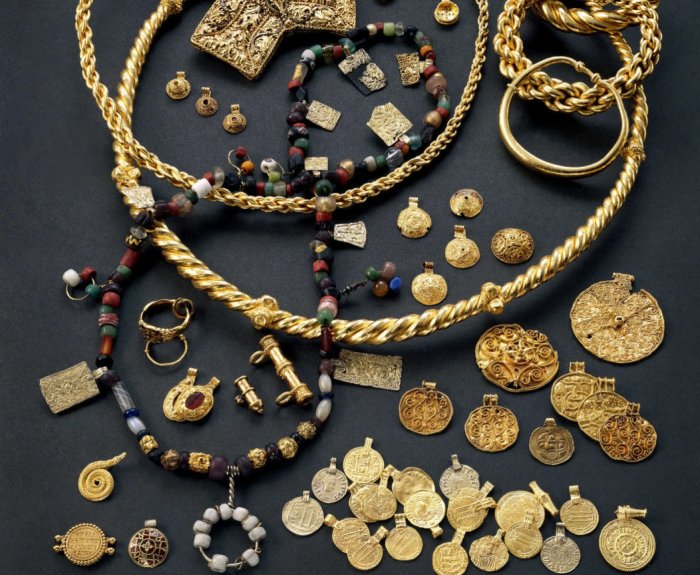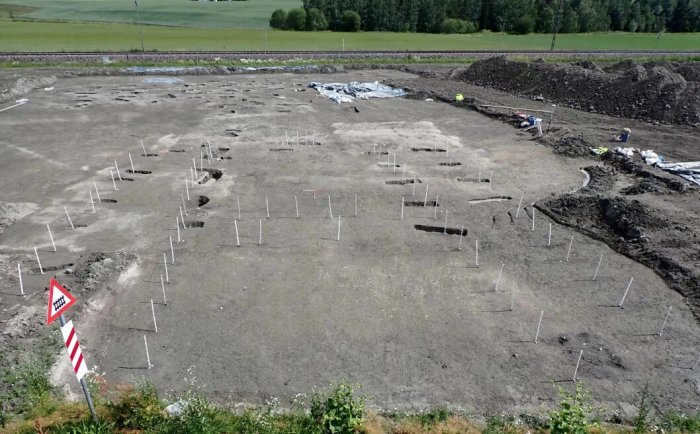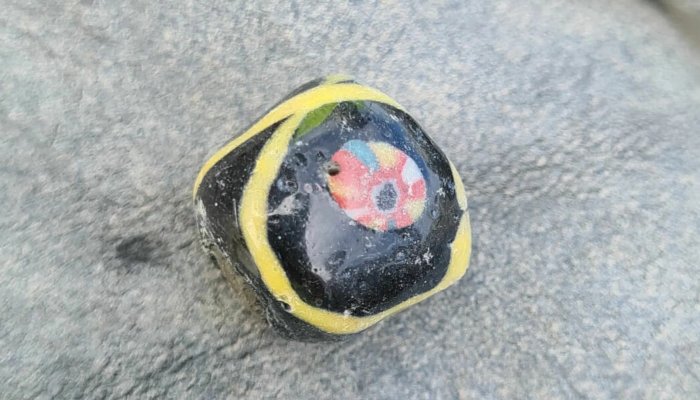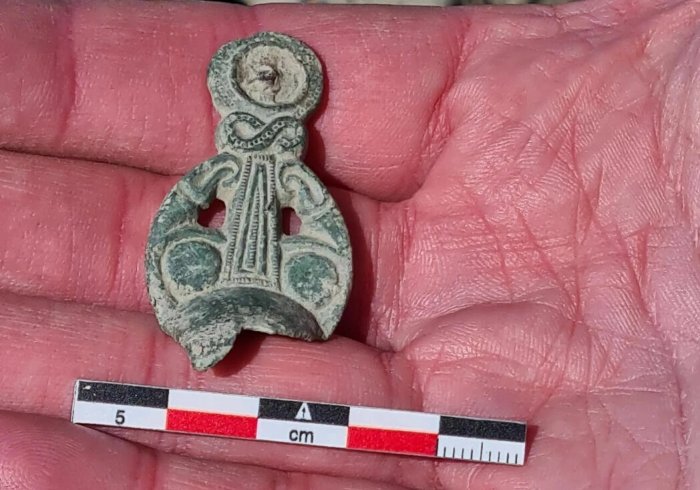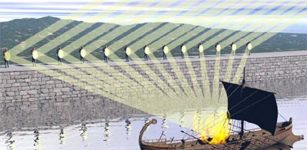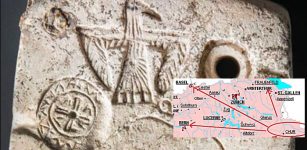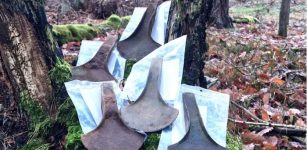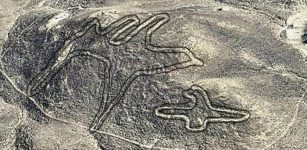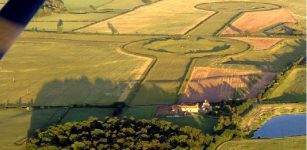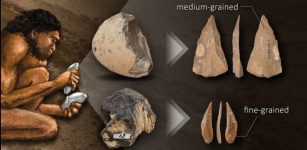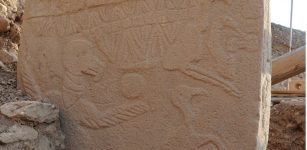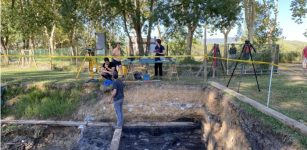Viking House The Size Of Two Tennis Courts Discovered In Norway
Jan Bartek - AncientPages.com - Archaeologists in Norway report they have discovered what seems to be a massive Viking house that has the length of almost two tennis courts.
The discovery was made when scientists excavated at an ancient royal estate site where they also unearthed an exquisite sword and many remnants of lavish parties.
It was in this rural field it once all went down, from the Bronze Age to around the 18th century. Thanks to discoveries made by metal detectorists, even more traces of the historical power centre at Sem in Norway have now been uncovered. (Photo: Fylkeskommune / Frank Rødberg)
“A finely ornamented handle for a knife or fork was found here during a metal search a few years ago,” says Christian Løchsen Rødsrud, the leader of the nearly three-month-long excavation at Sem in Eiker this summer.
The knife or fork is associated with King Christian IV, who was the king of Denmark and Norway from 1588 to 1648. He stayed at the royal estate at Sem several times.
“He must have enjoyed himself greatly; we have found so many remains of animal bones, mussels, oysters, and everything that a nobleman would have liked to indulge in,” archaeologist Rødsrud says. “Important people and a host of servants must have lived here.”
The Viking house is located on a field in the rural countryside one hour's drive from the Norwegian capital Oslo, and this place has once been a central seat of power.
A Viking Age treasure discovered in the former county Buskerud in 1834, known as the Hoen Hoard. One of the gold necklaces weighs nearly a kilo. To protect their treasures from thieves, many hid them in clever spots out in nature or in their houses. Archaeologists also believe treasures were buried as a sort of offering to the gods. Some such hidden treasures have since been found and are exhibited in museums – but there may still be more such treasures out there. (Photo: Museum of Cultural History, University of Oslo)
"It was already known that there was a royal estate here at Sem. But it was less known that this had been an important power centre during the Viking Age and even back to the Late Bronze Age.
This area is quite far inland. However, at that time, the water level was much higher. Large Viking ships sailed all the way in from what is now known as the Drammen Fjord.
But in the 18th century, this place lost its significance, and its history was forgotten," Science in Norway reports.
Everything changed in 2014 when two metal detectorists Steffen Hansen and Daniel Ødegård, suddenly found "coins from the Viking Age and the Middle Ages, two fragments of an Irish reliquary shrine, and pieces of a distinctive needle dating to the Bronze Age, around 600 years before our era.
Suddenly, it was not so surprising that the Hoen Hoard, the largest gold treasure from Norwegian Viking times, was found 2.5 kilometres away from Sem. And that the Solberg Vase, a truly unique vase from the Roman era, was found in a bog nearby. Both of these unique finds were made in the 19th century.
“What has been individual finds for us until now suddenly becomes part of a larger story,” Løchsen Rødsrud says. “This allows us to begin telling the story of the region in a different way. We are in a seat of power here.”
An unusually large house
As reported by Science in Norway, "one of the most exciting finds came, typically, towards the end of the excavation – a gigantic longhouse. The building reveals a series of postholes where the house's posts once stood. This is a common archaeological feature.
“But the proportions are very different,” Løchsen Rødsrud says.
An overview picture of the extraordinary house. Poles have been placed in the post holes. This is, however, only a small part of the house according to the archaeologists. (Photo: the Museum of Cultural History)
In typical prehistoric buildings, the roof is supported by load-bearing posts placed inside the building. In the building at Sem, it seems that the walls support the roof. There are nine metres between the two walls. This is a large span, even in modern construction.
Along both long sides, 3.5 metres outside the posts that supported the roof, more posts were found, indicating additional walls. Archaeologists believe they may have been slanted to strengthen the walls that supported the roof. These side aisles may also have been passageways.
The big question is which period of time the house belongs to."
Archaeologists have not yet excavated the whole site. However, scientists suspect the house is much longer.
“I expect the house is much longer. Twice or three times as long as it is wide,” Løchsen Rødsrud says.
Is it from the Viking Age? Or even older?
According to Jes Martens, an archaeologist at the Museum of Cultural History and project leader for the excavation at Sem, "the construction of the house resembles something that emerged during the Viking Age and is known from the Danish Viking fortresses.
A rectangular cooking pit is being documented and drawn. (Photo: the Museum of Cultural History)
“Several of these buildings were probably two stories high, as depicted on the Bayeux Tapestry, which tells of the Norman conquest of England,” Martens says.
“If these shards are not random, the house is much older than the aforementioned houses from the Viking Age. In that case, it's quite a sensation,” he says.
The archaeologists must await radiocarbon dating of charcoal and seeds collected during the excavation before they can clarify this.
“If it is a building from the Viking Age, it would likely be at least 40 metres long and nine metres high, based on what we have uncovered,” Martens says.
That would make the house almost the length of two tennis courts.
Feasting and revelry
As reported by Science in Norway, "near the remains of the massive building, traces of smaller houses have been found, which the archaeologists are certain date back to the 4th to 6th centuries. These houses are approximately 100-120 square metres in size and are likely associated with a series of cooking pits nearby. This corresponds to the Roman period/Migration period.
“They tell us something about the farm settlement at that time and their proximity to the cooking pits where they feasted and held gatherings,” Løchsen Rødsrud says.
One of the beads that was found in the cooking pits. Was it lost while the owner was having a merry time swinging around? (Photo: the Museum of Cultural History)
But the archaeologists have also found pottery that appears to come from the earlier Iron Age in the postholes.
Cooking pits where food was prepared are something archaeologists find everywhere. It is a somewhat mundane finding. Christian Løchsen Rødsrud refers to it as ‘archaeological bulk material’. However, these cooking pits are more intriguing because they were used for parties.
The everyday food during this time consisted of porridge and cereal products, prepared on hearths inside the houses.
In the cooking pits, there are bone remains and teeth from animals, including horses, sheep, and cattle, and even fish bones. There is also a lot of pottery in the cooking pits.
“And lo and behold, a couple of beads appeared in one of the pits,” Rødsrud says. “It’s not everyday fare in a cooking pit; it suggests festivities and revelry.”
“At times, larger celebrations were held, and animals were slaughtered. People drank, and political decisions were made. They probably brought the food into the longhouses and ate and drank there. So maybe a beaded necklace was lost in the process.”
One of several magnificent buckles from the Merovingian era that have been found at Sem. (Photo: the Museum of Cultural History)
Of course, the beads could have ended up there after the celebration, during everyday activities at the settlement.
Today, the cooking pits can be found in a vast field.
When there were celebrations here over 1,500 years ago, the cooking pits were on a headland, visible to those passing by on the Drammen Fjord.
The name Sem comes from the word Sjøheim, meaning 'sea home' or 'the house or place by the sea'. Perhaps the special location explains the unique finds made here.
See also: More Archaeology News
Archaeologists are not planning more excavating here this summer, but and there are plans to do a geo-radar survey in a few months.
"The secrets of the site will now be unearthed," the Museum of Cultural History wrote in a press release about the excavation at Sem. And the archaeologists are returning to the museum with a multitude of finds.
But an entire field full of secrets still remains untouched. Hopefully further studies of this fascinating site will shed more light on how, when and by whom the giant Viking house was used.
Written by Jan Bartek – AncientPages.com Staff


